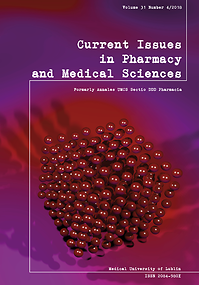Clinical and laboratory findings of patients with the possible diagnosis of influenza hospitalized in affiliated hospitals of Babol University of Medical Sciences, 2015-2016
DOI:
https://doi.org/10.1515/cipms-2018-0022Keywords:
clinical and laboratory findings, H1N1 influenza, IranAbstract
The clinical and para clinical manifestations of influenza in various patients have range from an autoimmune disease to a life-threatening respiratory infection. In addition, the severity of the disease is influenced by factors such as demographic factors, underlying diseases, and immune response. Therefore, in this study, we evaluated the clinical, laboratory and epidemiological characteristics of patients with this type of influenza in Babol (north of Iran). This study was conducted as a descriptive- cross-sectional study from October 2015 to March 2016. Subsequently, in this study, records of 123 patients with clinical signs of the influenza-like disease who have undergone the clinical sign in hospitals affiliated to Babol University of Medical Sciences were reviewed. Of 123 patients admitted to a possible diagnosis of influenza, 58 patients (47.2%) were PCR positive for H1N1, while seventy-nine (64.2%) participants were women and 21 (17.1%) had diabetes or underlying lung disease. Most of the involved age groups were of individuals above the age of 50. These were followed by the 21-35 years-old. Fever (78%), cough (65.9%), shivering (58.5%) and myalgia (56.1%) were the most common clinical symptoms. Increased levels of transaminases (43.1%), leukocytosis (35.8%) and thrombocytopenia (34.2%) were as well reported in patients as the most frequently reported para clinical findings. In the present study, the most usual clinical symptoms were fever, cough, chill, and myalgia, while gastrointestinal symptoms were also noticeably observed in patients. In an experimental study, a significant number of patients showed leukocytosis and thrombocytopenia and increased transaminases.
References
1. Ginsberg M, Hopkins J, Maroufi A, Dunne G, Sunega DR, Giessick, J, et al. Swine influenza A (H1N1) infection in two children-Southern California, March-April 2009. Morbidity and Mortality Weekly Report. 2009;58.
2. Clark AM, Nogales A, Martinez-Sobrido L, Topham DJ, DeDiego ML. Functional Evolution of Influenza Virus NS1 Protein in Currently Circulating Human 2009 Pandemic H1N1 Viruses. J Virol. 2017;91:e00721.
3. Veguilla V, López-Gatell H, López-Martínez I, Aparicio-Antonio R, Barrera-Badillo G, Rojo-Medina J, et al. A Large Proportion of the Mexican Population Remained Susceptible to A (H1N1) pdm09 Infection One Year after the Emergence of 2009 Influenza Pandemic. PloS One. 2016;11(3):e0150428.
4. Echevarría-Zuno S, Mejía-Aranguré JM, Mar-Obeso AJ, Grajales-Muñiz C, Robles-Pérez E, González-León M, et al. Infection and death from influenza A H1N1 virus in Mexico: a retrospective analysis. Lancet. 2010;374:2072-79.
5. Lee CW, Seo JB, Song JW, Lee HJ, Lee JS, Kim MY, et al. Pulmonary complication of novel influenza A (H1N1) infection: imaging features in two patients. Korean J Radiol. 2009;10:531-4.
6. Salmon DA, Proschan M, Forshee R, Gargiullo P, Bleser W, Burwen DR, et al. Association between Guillain-Barré syndrome and influenza A (H1N1) 2009 monovalent inactivated vaccines in the USA: a meta-analysis. Lancet. 2013;381:1461-8.
7. Launay E, Ovetchkine P, Saint-Jean M, Coïc L, Ducruet T, Charest H, et al. Novel influenza A (H1N1): clinical features of pediatric hospitalizations in two successive waves. Int J Infect Dis. 2011;15:e122.
8. Lapinsky SE. H1N1 novel influenza A in pregnant and immunocompromised patients. Crit Care Med. 2010;38:e52.
9. Baz M, Abed Y, Simon P, Hamelin MÈ, Boivin G. Effect of the neuraminidase mutation H274Y conferring resistance to oseltamivir on the replicative capacity and virulence of old and recent human influenza A (H1N1) viruses. J Infect Dis. 2010;201:740-5.
10 Du QS, Huang RB, Wang SQ, Chou KC. Designing inhibitors of M2 proton channel against H1N1 swine influenza virus. PloS One.2010;5:e9388.
11. Bautista E, Chotpitayasunondh T, Gao Z, Harper SA, Shaw M, Uyeki TM, et al. Clinical aspects of pandemic 2009 influenza A (H1N1) virus infection. New Engl J Med. 2010:362(18):1708-19.
12. Gouya MM, Nabavi M, Soroush M, Haghdoust AA, Ghalehee S, Hemmati P, et al. Mortality from Pandemic Influenza A (H1N1) in Iran. Iran Red Crescent Med J. 2011;13:698.
13. Khodadad N, Moattari A, Abadi MSS, Kadivar MR, Sarvari J, Tavakoli F, et al. Prevalence of Influenza A(H1N1)pdm09 Virus Resistant to Oseltamivir in Shiraz, Iran, During 2012-2013. Jundishapur J Microbiol. 2015;8:e23690.
14. Creanga AA, Johnson TF, Graitcer SB, Hartman LK, Al-Samarrai T, Schwarz AG,, et al. Severity of 2009 pandemic influenza A (H1N1) virus infection in pregnant women. Obstet Gynecol. 2010;115:717-26.
15. Carlson A, Thung SF, Norwitz ER. H1N1 influenza in pregnancy: what all obstetric care providers ought to know. Rev Obstet Gynecol. 2009;2:139.
16. Siston AM, Rasmussen SA, Honein MA, Fry AM, Seib K, Callaghan WM, et al. Pandemic 2009 influenza A (H1N1) virus illness among pregnant women in the United States. Jama. 2010;303:1517-25.
17. Quispe-Laime AM, Bracco JD, Barberio PA, Campagne CG, Rolfo VE, Umberger R, Meduri GU. H1N1 influenza A virus-associated acute lung injury: response to combination oseltamivir and prolonged corticosteroid treatment. Intensive Care Medicine. 2010;36:33-41.
18. Amorim VB, Rodrigues RS, Barreto MM, Zanetti G, Hochhegger B, Marchiori E. Influenza A (H1N1) pneumonia: HRCT findings. J Bras Pneumol. 2013;39:323-9.
19. Minodier L, Charrel RN, Ceccaldi PE, van der Werf S, Blanchon T, Hanslik T, Falchi A. Prevalence of gastrointestinal symptoms in patients with influenza, clinical significance, and pathophysiology of human influenza viruses in faecal samples: what do we know? Virol J. 2015;12:215.
20. Choi WJ, Kim WY, Kim SH, Oh BJ, Kim W, Lim KS, et al. Clinical characteristics of pneumonia in hospitalized patients with novel influenza A (H1N1) in Korea. Scand J Infect Dis. 2010;42:311-4.
21. Louriz M, Mahraoui C, Azzouzi A, El Fassy Fihri MT, Zeggwagh AA, et al. Clinical features of the initial cases of 2009 pandemic influenza A (H1N1) virus infection in an university hospital of Morocco. Int Arch Med. 2010;3:26.
22. Song JY, Cheong HJ, Heo JY, Noh JY, Yong HS, Kim YK, et al. Clinical, laboratory and radiologic characteristics of 2009 pandemic influenza A/H1N1 pneumonia: primary influenza pneumonia versus concomitant/secondary bacterial pneumonia. Influenza Other Respir Viruses. 2011;5:e535-43.
Downloads
Published
Issue
Section
License
Copyright (c) 2018 Autors

This work is licensed under a Creative Commons Attribution-NonCommercial-NoDerivatives 3.0 Unported License.


